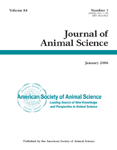-
Views
-
Cite
Cite
J. T. Vasconcelos, L. W. Greene, N. A. Cole, M. S. Brown, F. T. McCollum, L. O. Tedeschi, Effects of phase feeding of protein on performance, blood urea nitrogen concentration, manure nitrogen:phosphorus ratio, and carcass characteristics of feedlot cattle, Journal of Animal Science, Volume 84, Issue 11, November 2006, Pages 3032–3038, https://doi.org/10.2527/jas.2005-711
Close - Share Icon Share
Abstract
Two experiments with a randomized complete block design were conducted to determine the effects of phase feeding of CP on performance, blood urea nitrogen (BUN), manure N:P ratio, and carcass characteristics of steers fed in a feedlot. In Exp. 1, 45 crossbred steers (initial BW = 423 ± 3.3 kg) were individually fed a diet formulated to contain 13.0% CP (DM basis) for 62 d. On d 63, the dietary CP was maintained at 13.0% or formulated to contain 11.5 or 10.0% CP until slaughter. Actual CP values were 12.8, 11.8, and 9.9%, respectively. Reducing the CP concentration of the diet did not affect ADG of steers from d 62 to 109 (P = 0.54) or over the 109-d feeding period (1.45, 1.50, and 1.49 kg/d for 13.0, 11.5, and 10.0% CP, respectively; P = 0.85). No differences (P > 0.12) among treatments were detected for BUN concentrations on d 0, 62, or 109. Gain:feed, DMI, and carcass characteristics did not differ among treatments (P > 0.10). In Exp. 2, 2 trials were conducted using 184 (initial BW = 406 ± 2.6 kg) and 162 (initial BW = 342 ± 1.9 kg) crossbred steers. Data from the 2 trials were pooled for statistical analysis, and trial effect was added to the statistical model. Steers were fed a diet formulated to contain 13.0% CP until reaching approximately 477 kg. When the average BW of the pen was 477 kg, diets were maintained at 13.0% CP or reduced to contain 11.5 or 10.0% CP. Actual CP values were 12.4, 11.5, and 9.3% CP for treatments 13.0, 11.5, and 10.0% CP, respectively. Reducing the CP content of the diet did not affect ADG after the diet changed (P = 0.16) or throughout the finishing period (P = 0.14). Immediately before slaughter, steers fed the 13.0% CP diet had greater (P < 0.001) BUN concentrations than steers fed the 11.5 and 10.0% CP diets. Carcasses from cattle fed the 11.5% CP diet had greater (P = 0.02) fat thickness than the 13.0 and 10.0% CP treatments, whereas carcasses from cattle fed 13.0% CP had greater (P = 0.004) marbling scores than steers fed the 11.5 or 10.0% CP diets. Other carcass characteristics, DMI, and G:F did not differ (P > 0.10) among treatments. The N:P ratio was increased with the 10.0% CP diet (P = 0.02) compared with the 11.5 or 13.5% CP treatments; however, manure composition did not differ (P > 0.10) among treatments. These results indicate that reduced CP concentration during the finishing period does not affect feedlot performance but can improve the N and P relationship in the manure.





